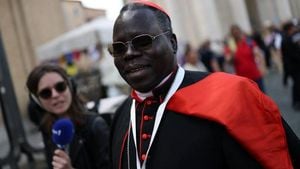The courtroom buzzed with tension as the trial of Daniel Penny took another dramatic turn when Judge Maxwell Wiley dropped the top charge of second-degree manslaughter against him. This decision came after the jury deliberated without reaching a unanimous conclusion, leaving the fate of Penny uncertain as he faced accusations tied to the death of Jordan Neely, a homeless man with mental health struggles.
Penny, who had garnered significant media attention, is widely known for placing Neely in a chokehold during what witnesses described as a chaotic incident on a Manhattan subway. Neely reportedly yelled at passengers, leading Penny, a former Marine, to intervene. The encounter escalated quickly, resulting in Neely's death, which sparked outrage and heated discussions about race, self-defense, and mental health.
News of the dropped charges was met with mixed reactions both inside and outside the courthouse. Activists from the Black Lives Matter movement protested, with one prominent leader, Hawk Newsome, making headlines for his bold statements. Newsome accused those who believed Penny acted innocently of harboring racism. "If you think he’s innocent, you have racism in your heart," he vehemently declared, drawing sharp criticism for what some perceived as intimidation tactics against the jury.
Onlookers noted the emotional charged atmosphere surrounding the trial, particularly after the jury, over multiple days of deliberation, indicated they were deadlocked on the manslaughter count. Under pressure to deliver some form of verdict, the prosecution opted to move forward with the lesser charge of criminally negligent homicide. This charge carries lighter penalties than the original manslaughter accusation, adding another layer to the complex narrative.
Former U.S. assistant attorney Andy McCarthy weighed in on the developments, condemning the district attorney’s approach as manipulative. McCarthy suggested there were strategic motivations behind the dismissal of the top charge aimed at securing some form of conviction, even if on lesser grounds. "It appears they attempted to influence the jury by creating this deadlock," he commented, reflecting the concerns many had about the integrity of the judicial process.
Legal experts have echoed similar sentiments, arguing the case highlights broader issues of race, justice, and public safety. According to some analysts, Penny’s case mirrors other controversial instances involving self-defense claims and the treatment of those who feel compelled to intervene during threatening situations. The parallels drawn to high-profile trials like those of Kyle Rittenhouse and others indicate the increased scrutiny on individuals who take justice actions outside conventional boundaries.
The charge of criminally negligent homicide will now face scrutiny as the jury is convened once again to deliberate. This next phase of the trial will not only test the legal standards involved but also challenge societal perceptions of heroism and vigilante justice. Penny's defense team remains cautiously optimistic, contending their client acted out of necessity rather than recklessness.
After Judge Wiley’s ruling, the atmosphere both inside the courthouse and on the streets outside seemed to reflect the wariness of every party involved. With heightened tensions and public opinions sharply divided, both the prosecution and defense gear up for what is sure to be another contentious moment as they head back to the jury.
Supporters of Penny argue he was justified in his actions, asserting they were necessary to protect himself and fellow passengers from Neely's aggressive behavior. Conversely, those opposed argue this justification cannot outweigh the tragic consequences of Neely's death, demanding accountability for what they label as excessive force.
The backdrop of this trial also brings to light the growing discourses surrounding mental health awareness—specifically, how society addresses the needs of marginalized individuals such as Neely. The narrative resonates deeply, as rampant discussions about the integration of public safety with mental health services and community support come to the forefront. This case serves as more than just about personal accountability; it reflects larger systemic issues needing to be addressed.
With the jury set to reconvene shortly, the pressure mounts for all parties involved. Their determination will not only influence Penny's future and potential criminal liability but will also echo across communities grappling with these challenging themes of race, class, and mental health.



